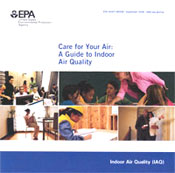Care for Your Air: A Guide to Indoor Air Quality
 EPA 404/F-08/008, September 2008 |
Understand indoor air in homes, schools, and officesSome pollutants in the air are especially harmful for children, elderly people, and those with health problems. Most of us spend much of our time indoors. The air that we breathe in our homes, in schools, and in offices can put us at risk for health problems. Some pollutants can be chemicals, gases, and living organisms like mold and pests. Several sources of air pollution are in homes, schools, and offices. Some pollutants cause health problems such as sore eyes, burning in the nose and throat, headaches, or fatigue. Other pollutants cause or worsen allergies, respiratory illnesses (such as asthma), heart disease, cancer, and other serious long-term conditions. Sometimes individual pollutants at high concentrations, such as carbon monoxide, cause death. Contents |
Learn about pollutants

Understanding and controlling some of the common pollutants found in homes, schools, and offices may help improve your indoor air and reduce your family’s risk of health concerns related to indoor air quality (IAQ).
Radon is a radioactive gas that is formed in the soil. It can enter indoors through cracks and openings in floors and walls that are in contact with the ground.
- Radon is the leading cause of lung cancer among nonsmokers, and the second leading cause of lung cancer overall.
Secondhand smoke comes from burning tobacco products. It can cause cancer and serious respiratory illnesses.
- Children are especially vulnerable to secondhand smoke. It can cause or worsen asthma symptoms and is linked to increased risks of ear infections and Sudden Infant Death Syndrome (SIDS).
Combustion Pollutants are gases or particles that come from burning materials. In homes, the major source of combustion pollutants are improperly vented or unvented fuel-burning appliances such as space heaters, woodstoves, gas stoves, water heaters, dryers, and fireplaces. The types and amounts of pollutants produced depends on the type of appliance, how well the appliance is installed, maintained, and vented, and the kind of fuel it uses. Common combustion pollutants include:
- Carbon monoxide (CO) which is a colorless,
odorless gas that interferes with the delivery of oxygen throughout the
body. Carbon monoxide causes headaches, dizziness, weakness, nausea, and
even death.
- Nitrogen dioxide (NO2) which is a colorless, odorless gas that causes eye, nose and throat irritation, shortness of breath, and an increased risk of respiratory infection.
Volatile organic compounds (VOCs) are chemicals found in paints and lacquers, paint strippers, cleaning supplies, varnishes and waxes, pesticides, building materials and furnishings, office equipment, moth repellents, air fresheners, and dry-cleaned clothing. VOCs evaporate into the air when these products are used or sometimes even when they are stored.
- Volatile organic compounds irritate the eyes, nose and throat, and cause headaches, nausea, and damage to the liver, kidneys, and central nervous system. Some of them can cause cancer.
Asthma triggers are commonly found in homes, schools, and offices and include mold, dust mites, secondhand smoke, and pet dander. A home may have mold growing on a shower curtain, dust mites in pillows, blankets or stuffed animals, secondhand smoke in the air, and cat and dog hairs on the carpet or floors. Other common asthma triggers include some foods and pollutants in the air.
- Asthma triggers cause symptoms including coughing, chest tightness, wheezing, and breathing problems. An asthma attack occurs when symptoms keep getting worse or are suddenly very severe. Asthma attacks can be life threatening. However, asthma is controllable with the right medicines and by reducing asthma triggers.
Molds are living things that produce spores. Molds produce spores that float in the air, land on damp surfaces, and grow.
- Inhaling or touching molds can cause hay fever-type symptoms such as sneezing, runny nose, red eyes, and skin rashes. Molds can also trigger asthma attacks.
Improving your indoor air
Take steps to help improve your air quality and reduce your IAQ-related health risks at little or no cost by:
Controlling the sources of pollution: Usually the most effective way to improve indoor air is to eliminate individual sources or reduce their emissions.
Ventilating: Increasing the amount of fresh air brought indoors helps reduce pollutants inside. When weather permits, open windows and doors, or run an air conditioner with the vent control open. Bathroom and kitchen fans that exhaust to the outdoors also increase ventilation and help remove pollutants.
Always ventilate and follow manufacturers’ instructions when you use products or appliances that may release pollutants into the indoor air.
Changing filters regularly: Central heaters and air conditioners have filters to trap dust and other pollutants in the air. Make sure to change or clean the filters regularly, following the instructions on the package.
Adjusting humidity: The humidity inside can affect the concentrations of some indoor air pollutants. For example, high humidity keeps the air moist and increases the likelihood of mold.
Keep indoor humidity between 30 and 50 percent. Use a moisture or humidity gauge, available at most hardware stores, to see if the humidity in your home is at a good level. To increase humidity, use a vaporizer or humidifier. To decrease humidity, open the windows if it is not humid outdoors. If it is warm, turn on the air conditioner or adjust the humidity setting on the humidifier.
Take Action to Improve Air Quality in Every Room
Important tips that will help control indoor pollutants
- Test for radon and fix if there is a problem.
- Reduce asthma triggers such as mold and dust mites.
- Do not let people smoke indoors.
- Keep all areas clean and dry. Clean up any mold and get rid of excess water or moisture.
- Always ventilate when using products that can release pollutants into the air; if products must be stored following use, make sure to close tightly.
- Inspect fuel-burning appliances regularly for leaks, and make repairs when necessary.
- Consider installing a carbon monoxide alarm.
Asthma is a serious, sometimes life-threatening respiratory disease that affects the quality of life for millions of Americans.
- Environmental asthma triggers: are found around the home and can be eliminated with simple steps.
- Don’t allow smoking in your home or car.
- Dust and clean your home regularly.
- Clean up mold and fix water leaks.
- Wash sheets and blankets weekly in hot water.
- Use allergen-proof mattress and pillow covers.
- Keep pets out of the bedroom and off soft furniture.
- Control pests—close up cracks and crevices and seal leaks; don’t leave food out.
Children are especially sensitive to secondhand smoke, which can trigger asthma and other respiratory illnesses.
Secondhand smoke: smoke comes from burning tobacco products such as cigarettes, pipes, and cigars.
- To help protect children from secondhand smoke, do not smoke or allow others to smoke inside your home or car.
Radon is the second leading cause of lung cancer.
Radon gas: enters your home through cracks and openings in floors and walls in contact with the ground.
- Test your home with a do-it-yourself radon kit. If the test result indicates you should fix, call a qualified radon mitigation specialist.
- Ask your builder about including radon-reducing features in your new home at the time of construction.
Mold can lead to allergic reactions, asthma, and other respiratory ailments.
Mold: can grow anywhere there is moisture in a house.
- The key to mold control is moisture control.
- If mold is a problem in your home, you should clean up the mold promptly and fix the water problem.
- It is important to dry water-damaged areas and items within 24-48 hours to prevent mold growth.
VOCs cause eye, nose, and throat irritation, headaches, nausea, and can damage the liver, kidney, and central nervous system.
Volatile organic compounds (VOCs): are chemicals that evaporate at room temperature. VOCs are emitted by a wide array of products used in homes including paints and lacquers, paint strippers, varnishes, cleaning supplies, air fresheners, pesticides, building materials, and furnishings. VOCs are released from products into the home both during use and while stored.
- Read and follow all directions and warnings on common household products.
- Make sure there is plenty of fresh air and ventilation (e.g., opening windows and using extra fans) when painting, remodeling, or using other products that may release VOCs.
- Never mix products, such as household cleaners, unless directed to do so on the label.
- Store household products that contain chemicals according to manufacturers’ instructions.
- Keep all products away from children!
Carbon monoxide causes headaches, dizziness, disorientation, nausea and fatigue, and high levels can be fatal.
Nitrogen dioxide causes eyes, nose, and throat irritation, impairs lung function, and increases respiratory infections.
Sources include: indoor use of furnaces, gas stoves, unvented kerosene and gas space heaters, leaking chimneys, and tobacco products.
- Ventilate rooms where fuel-burning appliances are used.
- Use appliances that vent to the outside whenever possible.
- Ensure that all fuel-burning appliances are properly installed, used, adjusted, and maintained.
Remodeling old homes and building new homes

While remodeling or improving the energy efficiency of your home, steps should be taken to minimize pollution from sources inside the home, either from new materials or from disturbing materials already in the home. In addition, residents should be alert to signs of inadequate ventilation, such as stuffy air, moisture condensation on cold surfaces, or mold and mildew growth.
When building new homes, homebuyers today are increasingly concerned about the IAQ of their homes. Pollutants like mold, radon, carbon monoxide, and toxic chemicals have received greater attention than ever as poor IAQ has been linked to a host of health problems. To address these concerns, builders can employ a variety of construction practices and technologies to decrease the risk of poor IAQ in their new homes using the criteria from EPA’s Indoor airPLUS as a guide.
To help ensure that you will have good IAQ in your new or remodeled home:
- Ask about including radon-reducing features.
- Provide proper drainage and seal foundations in new construction.
- Consider installing a mechanical ventilation system. Mechanical ventilation systems introduce fresh air using ducts and fans, instead of relying on holes or cracks in the walls and windows.
- When installing new appliances (like furnaces) make sure they are installed properly with a good vent or flue.
Schools

With nearly 56 million people, or 20 percent of the U.S. population, spending their days inside elementary and secondary schools, IAQ problems can be a significant concern. All types of schools—whether new or old, big or small, elementary or high school—can experience IAQ problems. School districts are increasingly experiencing budget shortfalls and many are in poor condition, leading to a host of IAQ problems.
- EPA’s voluntary
Indoor Air Quality Tools for Schools Program provides district-based guidance to schools about best practices, industry guidelines, and practical management actions to help school personnel identify, solve, and prevent IAQ problems.
- Children may be more sensitive to pollution, and children with asthma are especially sensitive. Asthma is responsible for millions of missed school days each year. Parents’ and caregivers’ involvement helps daycare facilities become aware of asthma triggers and the need to reduce them.
Office Buildings

Many office buildings have poor IAQ because of pollution sources and poorly designed, maintained, or operated ventilation systems.
- Office workers help to improve the indoor air in their buildings by paying attention to environmental conditions including ventilation, temperature, and the presence of odors. Report any problems to facility managers immediately.
- To improve IAQ, be careful not to block air vents or grilles, keep your space clean and dry, and do not bring in products that may pollute the indoor air.
![[logo] US EPA](https://webarchive.library.unt.edu/eot2008/20090510100134im_/http://www.epa.gov/epafiles/images/logo_epaseal.gif)
